Mercedes-Benz 300 SL
The Mercedes-Benz 300 SL (chassis code W 198) is a two-seat sports car that was produced by Mercedes-Benz as a gullwinged coupe (1954–1957) and roadster (1957–1963).[2] It was based on the company's 1952 racer, the W194, with mechanical direct fuel-injection which boosted power almost 50% on its 3-litre overhead camshaft straight-6 engine.[3] Capable of reaching a top speed of up to 263 km/h (163 mph), it was both a sports car racing champion[4] and the fastest production car of its time.[3]
| Mercedes-Benz 300 SL | |
|---|---|
300 SL Roadster beside the Coupe version | |
| Overview | |
| Manufacturer | Mercedes-Benz |
| Production | 1954–1957 (Coupe) 1957–1963 (Roadster) 3,258 built[1] Coupe: 1,400 Roadster: 1,858 |
| Assembly | West Germany: Stuttgart-Untertürkheim |
| Body and chassis | |
| Class | Sports car / Grand tourer |
| Body style | 2-door Coupe, Roadster |
| Layout | FR layout |
| Platform | Coupe W198 I, Roadster W198 II |
| Doors | Gull-wing (Coupe) Conventional (Roadster) |
| Related | Mercedes-Benz W121 BII (190 SL) |
| Powertrain | |
| Engine | 2,996 cc (182.8 cu in) M198 Straight six |
| Transmission | 4-speed manual |
| Dimensions | |
| Wheelbase | 2,400 mm (94.5 in) |
| Length | 4,520 mm (178.0 in) |
| Width | 1,790 mm (70.5 in) |
| Height | 1,300 mm (51.2 in) |
| Curb weight | Coupe 1,500 kilograms (3,300 pounds), Roadster 1,560 kilograms (3,440 pounds), from 1961 1,660 kilograms (3,660 pounds) |
| Chronology | |
| Predecessor | Mercedes-Benz W194 (racing car) |
| Successor | by name: Mercedes-Benz W113 (230SL) spiritual: Mercedes-Benz SLS AMG |
The 300 SL was inspired by Max Hoffman, Mercedes-Benz's authorized United States importer at the time, who correctly perceived a large American market for such a car. The company introduced the 300 SL in February 1954 at the International Motor Sports Show in New York instead of in Europe in order to get it into U.S. buyers' hands sooner.
SL is the short form for "super-light" in German,[5] Mercedes' first use of the designation, referring to the car's racing-bred light tubular frame construction.
The 300 SL was voted the "sports car of the century" in 1999.[6]
Development
Origin in the W194 racing car
The 300 SL (also called W198) traces its origin back to a racing sports car, the Mercedes-Benz W194. In 1951, Daimler-Benz decided to take part in races and build a sports car for this purpose. Mercedes' largest engine, the M186 shared between the 300 "Adenauer" saloon (W186) and luxurious 300 S two-seat tourer (W188), was developed.[7]
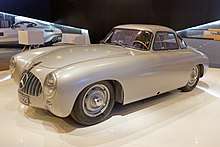
In 1952, the W194 took part in the most important races of the year. The new SL competed in the Mille Miglia at the beginning of May and achieved second place. It won the top three places at the Bern Sports Car Prize 131.04 kilometres (81.42 mi). At the 24-hour race at Le Mans, the 300 SL won the top two places. First place went to Hermann Lang and Fritz Riess with an overall average 155.6 km/h (96.7 mph), they achieved a new record in Le Mans history. Second place went to Theo Helfrich and Helmut Niedermayr. A race at the Nürburgring ended with a four-fold success. At the Carrera Panamericana in Mexico, the 300 SL again won with Karl Kling and Hans Klenk – despite having a vulture flying through the windscreen.[8]

These successes, especially those on the high-speed open road races, were rather surprising as the W194 engine was fitted only with carburetors, producing 175 hp (130 kW), which was not only less than the competing cars by Ferrari and Jaguar, but also less than the 300 SL road car developed from it and introduced in 1954. Low weight and low aerodynamic drag made the W194 fast enough to be competitive in endurance races.

Mercedes-Benz developed a new version for the 1953 racing season by adding fuel injection and 16-inch wheels. The gearbox was installed on the rear axle. Its body was made of Elektron, a magnesium alloy, to reduce the weight by 85 kilograms (187 pounds). However, the car was not used because Mercedes-Benz decided to take part in Formula One from 1954 onward.[9] Later versions revised the body for lower air resistance and did not adopt the transmission arrangement.
Start of the 300 SL
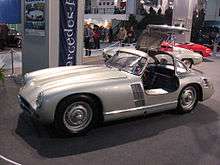
Mass production of the 300 SL was initially not planned. The idea of a toned-down Grand Prix car tailored to affluent performance enthusiasts in the booming post-war American market was suggested by Max Hoffman at a director's meeting in Stuttgart, in 1953.[10][3] Mercedes' new General Director Fritz Konecke agreed when Hoffman put an order in for 1000 cars[10] and the new 300 SL was introduced at the 1954 New York Auto Show rather than the Frankfurt or Geneva gatherings where company models made their usual debuts. In addition, the production of a smaller Roadster, the Mercedes-Benz 190 SL was announced[11] after Hoffman put another order in for 1000 of the 190SLs[10]
The two sports cars premiered at the "International Motor Sports Show" in New York, which took place in February 1954. Mercedes-Benz experienced a very positive visitor response to the 300 SL and the 190 SL at the Motor Show. Serial production began in August 1954 at the Sindelfingen plant.
Cost
The price for the Coupe in Germany was DM 29,000 and $6,820 in the US.[10] The Roadster was DM 32,500 in Germany and $10,950 in the US – a 10% jump in Europe but an over 60% increase in the US over the Coupe.[12]
| Option | Price (USD) |
|---|---|
| Colour other than metallic silver | 65 |
| Bumper guards (4) | 40 |
| Windscreen washers | 18 |
| Becker radio | 264 |
| Leather upholstery for Coupe | 165 |
| Fitted luggage for Roadster | 85 |
| Crated shipment from factory | 80 |
| Competition springs (4) | 88 |
| Competition front shock absorbers (2) | 41 |
| Competition rear shock absorbers (2) | 85 |
| Competition camshaft | 73 |
| Rudge wheels (5) | 350 |
| Optional ring and pinion gears, per set | 80 |
| Hardtop for Roadster | 178 |
Sport-Leicht or Super-Leicht
Mercedes-Benz did not announce what the abbreviation "SL" meant when the car was introduced and various magazines and company officials have gone back and forth between Sport Leicht and Super Leicht (light).[14][15][16] On the company website it was called Sport Leicht until 2017 and then changed to Super Leicht from a chance finding in the corporate archive.[17][18]
300 SLS
_2009-08-07_ret2.jpg)
A special 300 SLS (Super Light Special) version of the 300 SL Roadster was created for the Mercedes-Benz U.S. racing team to compete in the Sports Car Club of America (SCCA) national circuit in 1957. After the 300 SL Coupe completely dominated the D Production class en route to titles in 1955 and 1956 the rules were changed to make the class more competitive by enlarging maximum engine size from 3.0 to 3.5 litres. Rather than radically modify its engine size (on the cusp of releasing the company's new 300 SL Roadster to replace the Coupe), Mercedes-Benz instead created two specially modified Roadsters to campaign in the D Modified class on the SCAA circuit. These featured a solid cover over the passenger seat, a low profile racing screen in place of a full-width and height windscreen, a driver's seat roll bar, a custom cowl with engine air intake, and a lack of front and rear bumpers. These and other modifications lowered vehicle weight from 1,420 kilograms (3,130 pounds) to 1,040 kilograms (2,290 pounds). Engine output was increased 20 hp (15 kW) to 235 hp (175 kW). Team driver Paul O'Shea once again brought home the title for the company.[4]
Overview
The 300 SL has a weight-saving tubular frame atop a steel chassis, with a steel body attached to the frame. To further reduce weight, its bonnet, doors, dashboard and boot lid were made of aluminum. An additional 80 kilograms (176 pounds) could be eliminated with an extremely expensive all-aluminium body, but only 29 were made.[10]
The maximum speed of the 300 SL is 263 km/h (163 mph), and depending on the rear axle ratio fuel consumption was 17 L/100 km (17 mpg‑imp; 14 mpg‑US).
Interior
Three checkered pattern seats fabrics were available as standard. The combinations of the basic colours were, grey/green, grey/blue and cream/red.[19] Most customers opted for leather upholstery, which became standard on the Roadster.
Even with the upward opening doors the Coupe has an unusually high sill, making entry and exit from the car's cockpit problematic. To further facilitate entry the steering wheel pivoted on its hub 90 degrees away from the dashboard.[20]
Storage space for luggage is only behind the seats in the Coupe as the boot only fits a spare wheel and fuel tank. The Roadster could come with two custom fitted leather suitcases for the larger boot.
The side windows in the Coupe are fixed, but roll down normally in the Roadster.
 Fabric seats, in a distinctive plaid pattern, were standard on the Coupe
Fabric seats, in a distinctive plaid pattern, were standard on the Coupe- Leather seats were optional
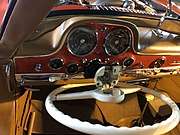 The steering wheel could be released and tilted down or away to aid in entry and exit
The steering wheel could be released and tilted down or away to aid in entry and exit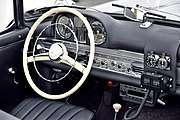 Roadster dashboard (with aftermarket gauge pod on right)
Roadster dashboard (with aftermarket gauge pod on right)- The car's tubular frame caused luggage capacity to be severely limited in the Coupe
Exterior
The body consists mainly of sheet steel, with the bonnet, boot lid, dashboard, sill and door skins made of aluminium. Silver grey was the standard colour; all others were options at an additional expense.[21]
The objective of the overall design was to make the vehicle as streamlined as possible. The exceptional width of the tubular frame along the cockpit allowed the cabin roofline to be inset considerably on both sides, dramatically reducing frontal area. The frame, however, was also quite high along the midline, prohibiting the attachment of normal doors. The only option – already used on the W194 race car – that would allow passengers up and over an exceptionally high and deep sill were the now iconic gull-wing doors. Rather than an aesthetic choice, they were a design necessity.
Eyebrows are a stylistic feature that also stretch the curvaceous body.[22][23] The front pair deflect road water from hitting the windscreen and the rear had to be added for visual symmetry.[24] These eyebrows give styling to an otherwise slab-sided body. Mercedes-Benz claimed they were aerodynamic additions and pushed airflow over the top of the car and kept the windows clean in bad weather.[25]
 Any colour other than metallic silver was an extra charge
Any colour other than metallic silver was an extra charge Detail of a restored coupe
Detail of a restored coupe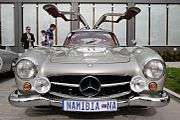 The iconic "gullwing" pose
The iconic "gullwing" pose
Engine
The Mercedes-Benz M198 engine is a water cooled 3.0 L; 182.8 cu in (2,996 cc) overhead cam straight-six. Like the racing Mercedes-Benz M194, the 300 SL borrowed the basic 2 valve per cylinder M186 engine from the regular four-door 300 (W186 "Adenauer") luxury tourer introduced in 1951.[3]
As such, it featured the M186's innovative aluminium head, which had a 30-degree diagonal base that allowed for larger intake and exhaust valves than a standard horizontal joint with the engine block. To improve performance, the M198 replaced the W194's triple two-barrel Solex carburetors with a Bosch mechanical direct fuel injection system.[3] Derived from the DB 601 V12 used on the Messerschmitt Bf 109E fighter of World War II, it boosted power almost 25% over the Gran Prix car's, raising output from 175 hp (130 kW; 177 PS) SAE gross to 240 hp (179 kW; 243 PS) SAE gross at 6100 rpm (215 hp (160 kW; 218 PS) DIN at 5800 rpm), over double that of the original Type 300 saloon's 115 hp (86 kW; 117 PS) SAE gross.[26] Compression was set at 8.55:1.[10]
Another high-performance feature was race-bred dry sump lubrication, which both ensured good oil distribution at high-speed cornering and reduced engine height by eliminating a traditional oil pan.
A free optional, even more powerful version of the M198, with radical Sports camshaft and 9.5:1 compression ratio,[10] could be ordered for the Coupe. The Roadster was delivered with this engine only on its debut in 1957.
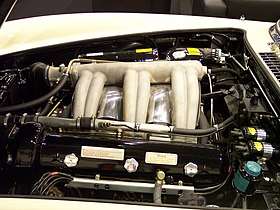
In order for the M198 to be installed in the low profile car, it was tilted 50 degrees toward the driver's side.[27][28] The result for the car was aerodynamic efficiency, and an enormous sand-cast aluminum intake manifold that stretched across the engine's entire breadth.[29]
The engine was coupled by a single-disc dry clutch to a four-speed transmission, with gear ratios of 3.34:1, 1.97:1, 1.39:1, and 1:1, and a reverse of 2.73:1.[26] The stock rear axle ratio at the beginning of the construction period was 1:3.42; From the 41st vehicle, it was changed to 1:3.64 to give better acceleration. It allows a top speed of 235 km/h (146 mph) and acceleration from 0 to 100 km/h (62 mph) in 9.3 seconds. Faster acceleration was provided with ratios of 1:3.89 and 1:4.11. The lowest final gear ratio, of 1:3.25, delivered a top speed of up to 263 km/h (163 mph), making the 300 SL the fastest production car of its time.[3]
City drivers found the tall first gear a challenge.[11] Clutch pedal operation was initially very heavy, remedied by an improved clutch arm helper spring.
Adapting a race-bred mechanical direct fuel-injection system proved not without problems. Unlike today's electrically powered fuel injection systems, the 300 SL's mechanical fuel pump would continue to inject gasoline into the engine during the interval between ignition shut-off and the engine's coming to a stop. This both washed away the oil film critical to an engine during start-up and led to oil dilution, leading to excessive ring wear and scouring of the cylinder walls. Exacerbating the problem was the engine's racing-oriented dry sump lubrication system, with its large oil cooler and enormous 15 l (4.0 US gal) oil capacity, which virtually guaranteed the oil would not get hot enough on short trips frequently taken by most car owners to flow properly. In practice, many would block off airflow through the oil cooler and stick rigidly to the appropriately low 1,600 km (1,000 mi) recommended oil change interval. An auxiliary fuel pump provided additional fuel for extended high-speed operation or cold starts, but overuse could also lead to dilution of the oil.[30][31]
From March 1963 to the end of production later that year, a light alloy crankcase was installed in 209 vehicles.[32]
Chassis
.jpg)
As is the case with contemporary racing cars, the 300 SL has a tubular frame designed by Mercedes' head engineer Rudolf Uhlenhaut. This ensured high stability with low vehicle mass. Thin straight chrome-molybdenum tubes were assembled as several triangles and the finished frame weighs 82 kilograms (181 pounds). The tubes make a deep side panel so gullwing doors are needed to enter the car.[33] The frame on the Coupe has two side rails with the top tube at the level of the driver's elbow.[10] The centre of gravity is almost exactly in the middle of the vehicle.

The chassis was a regular Mercedes-Benz W186 but with a sportier tuning. Unlike many cars of the 1950s, recirculating ball steering was relatively precise and the four-wheel independent suspension allowed for a reasonably comfortable ride and markedly better overall handling. Front suspension was double wishbones, coil springs, stabilizing bar. However, the rear swing axle, jointed only at the differential, not at the wheels themselves, could be treacherous at high speeds or on imperfect roads due to extreme changes in camber. The Coupe has a high-pivot swing axle, radius arms, coil springs. This was replaced with a low-pivot swing axle in the Roadster.[10]
Wheels
The front wheels are hung on double, unequal length wishbones with coil springs and hydraulic telescopic shock absorbers and a torsion bar stabilizer was installed. The Coupe's rear axle was of a two joint design with one joint at each side of the differential at its centre line.[19]
The Coupe's wheels were 5K × 15 inches while the Roadster was slightly larger at 5.5 x 15 inches. The wheels were steel bowl/aluminium rim rivet compound wheels. A valuable option was the Rudge rims 5J × 15 inches. The tires were 6.50-15 inches on the Coupe and 6.70–15 on the Roadster.
.jpg)
The 300SL had the same 1,470 square centimetres (227.9 sq in) area, self cooled, turbo drum brakes as on the 300S Mercedes.[34] A brake booster was used to reduce the pedal force. The brake booster works by using the negative pressure in the intake manifold. Brake shoes were 90 millimetres (4 in) wide. The front drum brakes were 2 wheel brake cylinders/wheel, rear drum brakes were 1 wheel brake cylinder/wheel. The handbrake was a mechanical parking brake that acts on the rear wheels. The Roadster had the same drum brakes until March 1961 when Ø 290 millimetres (11.4 in) disc brakes were introduced front and rear.[20]
Roadster
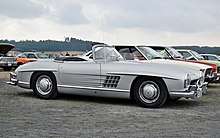

In mid-1956 Mercedes was evaluating what to do with the Coupe. Sales of the Coupe had started to fall off and the board decided to show a convertible version at the Geneva show in March and convert the factory completely to the Roadster in May 1957 to meet the needs of the California market.[10][34]
Built with conventional doors, the 300SL Roadster was first exhibited at the Geneva Salon in May 1957.[10][34] The production of an open 300SL involved altering the cockpit area, where the space frame was redesigned to permit lower sills for improved access.[10][34] At the same time the rear suspension was changed to incorporate low-pivot swing axles.[10][34]
The Roadster at 1,420 kilograms (3,131 pounds) weighs 125 kilograms (276 pounds) more than that of the Coupe, but with 240 hp (179 kW) the Roadster has slightly more power. The tubular frame on the Roadster still supported the body, but was changed to create more space in the boot. The spare tire was placed under boot floor and combined with a smaller fuel tank gave room for specially made fitted luggage. The lower door-line closer to the ground gives a much more comfortable entry.[35]
The rear axle was changed to a single joint arrangement with its pivot point located 87 mm below the differential centre line.[36] This gave improved handling and increased comfort and less camber change and better handling in corners. Uhlenhaut wanted the new low pivot axle for the Coupe but was voted down by the Board of Directors, reminding him that 3000 manufactured axle units remained at the factory and costs were already getting very high for this car.[10] A hardtop became an available option from September 1958.[10]
Reception and sales
Dealers needed to train mechanics to maintain the racing-style fuel injection system. Sales quintupled in the model's second year but dropped-off over the next three years.[10] Roadster sales were initially high then leveled off to about 200 a year.
Production numbers
| 1954 | 1955 | 1956 | 1957 | 1958 | 1959 | 1960 | 1961 | 1962 | 1963 | Total | Known to exist in 1994 | ||||
|---|---|---|---|---|---|---|---|---|---|---|---|---|---|---|---|
| Coupe | 166 | 856 | 308 | 70 | 1,400 | 1,200 | |||||||||
| Roadster | 618 | 267 | 200 | 241 | 256 | 182 | 94 | 1,858 | 1,458 | ||||||
| Total | 166 | 856 | 308 | 688 | 267 | 200 | 241 | 256 | 182 | 94 | 3,258 | 2,658 | |||
Famous owners
Numerous celebrities have owned 300 SLs. Among them, Mohammad Reza Pahlavi, Wernher von Braun[38] Rob Walker, Juan Manuel Fangio, Juan Peron, Tony Curtis, Pablo Picasso,[39] Sophia Loren, Romy Schneider, Clark Gable, Glenn Ford,[40] Briggs Cunningham, Luigi Chinetti, John von Neumann,[37] Pierre Trudeau, Justin Trudeau,[41] Paul Newman, Yul Brynner, Bernie Ecclestone, Ralph Lauren, Frank Lloyd Wright[42] and Adrian Conan Doyle.[43], King Abdullah II of Jordan
Racing
Mercedes reentered racing at the 1952 Mille Miglia and entered three 300 SL teams finishing 2nd and 4th.
Werner Engel won the 1955 European Rally Championship driving a 300 SL.[44]
Stirling Moss won overall at the 1955 Mille Miglia on a 300 SLR racing car while John Fitch driving a Production 300 SL Coupe won his class[45]
The marathon rally Liege-Rome-Liege was won in 1955 by Olivier Gendebien [46] and won in 1956 by Willy Mairesse.
Competing in Class D, a 300 SL won the Sports Car Club of America championship three years running from 1955–1957.
Over three hundred 300 SLs were counted in the parking lot of the annual 12 Hours of Sebring endurance race in 1956.[4]
In the United States, Paul O'Shea became a champion in the Class D racing class in 1957 in a Roadster.
The car also had a victory in the Rali Vinho da Madeira in 1960.
Wins by the 300 SL W-194 Facrory Race cars in the 1952 Carrera Pan-Americana and at Le Mans followed,
The car had a top speed of 160 mph (257 km/h) vs 180 mph (290 km/h) for the Ferraris and Maseratis it competed against.
Instead, it was to be the most durable and able to maintain its top speed for over 11 hours in some races.[47]
Bob Sirna, a previous president of the Gull Wing Group International organization set a new Bonneville Speedway F/GT speed record in 2016 in a highly modified Coupe, establishing a new high speed for a 3L Sport car of 190.759 mph (306.997 kilometres per hour).[48]
Legacy
_%26_Mercedes-Benz_300_SL_(W_198)_%E2%80%93_Frontansicht%2C_10._August_2011%2C_D%C3%BCsseldorf.jpg)
A less expensive, 1.9 litre Roadster was introduced in 1955 as the Mercedes 190SL. This was followed by the 230 SL.
Sports Car International magazine ranked the 300 SL as the number 5 sports car of all time.
Subsequent generations of the Mercedes-Benz SL-Class have been continually produced such as the Mercedes-Benz W113 (1963–71) and the Mercedes-Benz R129 (1989–2001). However, the SL has since evolved to become a more autobahn-focused grand tourer due to increasing weight, especially with its optional V12 engine in later iterations.[49] The last two generations of the SL are hardtop convertibles with technological and comfort amenities.[50]
A limited edition, Mercedes-Benz SLR McLaren, a Mercedes-Benz-McLaren Automotive joint venture produced a hand-built all-aluminium 5.4 l (330 cu in), 626 PS (460 kW; 617 hp) supercharged V8 in 2003. A 571 PS (420 kW; 563 hp) 6.2 l (380 cu in) V8 powered Mercedes-Benz SLS AMG made its debut in 2009. Described by Mercedes as a spiritual successor to the 300 SL Coupe.[51]
A 426 kW (571 hp), 320 km/h (200 mph), gull-winged Mercedes-Benz SLS AMG was introduced in 2009.[51]
SLS AMG production was brought to a close at the end of 2014.[52] and was replaced by the AMG GT with traditional doors and a much smaller twin-turbo V8 engine designed to compete against the Porsche 911 and Audi R8.[53]
300 SL members are supported by the Gull Wing Group International which started in 1961.[54]
As part of a partnership between Mercedes-Benz and Nintendo, the Wii U game Mario Kart 8 and its Nintendo Switch update Mario Kart 8 Deluxe feature a 300 SL Roadster as a playable in-game vehicle, added as part of a post-launch downloadable game update on August 27, 2014.[55]
References
Citations
- Oswald, Werner (2001). Deutsche Autos 1945–1990, Band 4. Stuttgart: Motorbuch Verlag. ISBN 978-3-613-02131-0.
- Werner Oswald: Mercedes-Benz Personenwagen 1945–1985. Motorbuch Verlag, Stuttgart 2007, ISBN 978-3-613-02778-7, S. 46 u. 70.
- LaPalm, Julia (9 January 2013). "Uberbird: The Most Important Postwar Benz of Them All". Motortrend. Archived from the original on 27 December 2018. Retrieved 25 December 2018.
- When Mercedes-Benz Dominated SCCA Racing in the 1950s, Sports Car Digest
- Benjamin Bessinger: Mercedes-Konzernarchiv. 15 Regalkilometer Autogeschichte. Archived 10 September 2018 at the Wayback Machine In: Die Zeit, 14. April 2017, S. 2.
- Bernd Ostmann: Mercedes-Sportwagen. Gipfeltreffen von drei Generationen. Archived 9 April 2017 at the Wayback Machine In: Auto motor und sport, 12 February 2011.
- Michael Rieder: Urahn-Forschung. In: Motor Klassik, 1989, Heft 5, S. 14.
- Doppelsieg trotz Pleitegeier Archived 19 December 2018 at the Wayback Machine, Mercedes-Benz.com, abgerufen am 12. Januar 2018
- Daimler-Media: "Der Mercedes-Benz 300 SL (W 194) mit der Chassisnummer 11". Media.daimler.com. 26 March 2012. Retrieved 25 July 2017.
- Nitske, Robert (1974). Mercedes-Benz 300 SL. Motorbooks International. ISBN 978-0879380212.
- Die klassischen Mercedes SL. Motor Klassik, Spezial Nr. 3, Vereinigte Motorverlage, Stuttgart.
- US prices: Mike Covello: Standard Catalog of Imported Cars 1946–2002, Krause Publication, Iola 2002, ISBN 0-87341-605-8, p. 527-31
- "300 SLR Tech Report". Sports Cars Illustrated. 1 (10). April 1956.
- Jochen Übler (19 April 2012), "Trimm's Leicht", Auto, Motor und Sport, Mercedes SL-Spezial 2012 (in German) (10), pp. 14–17, ISSN 0005-0806
- Günter Engelen, Mike Riedner, Hans-Dieter Seufert (1999), Mercedes-Benz 300 SL (in German) (2 ed.), p. 31, ISBN 978-3-613-01268-4CS1 maint: multiple names: authors list (link)
- Gerold Lingnau (2002), "300SL – Die Ikone wird fünfzig", Mercedes-Benz Classic (in German) (1), pp. 10–22, ISSN 1610-8043
- Motorsport als Zündfunke: Der Mercedes-Benz 300 SL Rennsportwagen der Baureihe W 194 (1952–1953). In: media.daimler.com, aufgerufen am 25. Juli 2017.
- Foto: Dokument des Namenvorschlags Archived 24 December 2018 at the Wayback Machine in: Die Zeit, 14. April 2017.
- Faszination. ISBN 978-3613305144.
- Mercedes-Benz 300 SL. Test in Auto, Motor und Sport, Motorbuch Verlag, Stuttgart, Heft 21/1955, Reprint in Motor Klassik, Spezial Nr. 3.
- Thomas Imhof, Mercedes SL, Moevig 1990, S. 20.
- "The design of the Mercedes-Benz SL-Class". Retrieved 12 November 2019.
- "The Original Supercar: The Mercedes-Benz 300SL". 18 June 2017. Retrieved 12 November 2019.
- "The Roadster body-type of the 300 SL is yet another example of hand crafted beauty". Retrieved 12 November 2019.
- Mercedes-Benz SL Series Recognition and Fact Guide. pp. 19–20. ISBN 9781583882832.
- Zal, Pawel. "1954 Mercedes-Benz 300 SL opt. 3.42 axle". Automobile-catalog.com. Retrieved 8 December 2018.
- Mercedes 300 SL Technical data booklet (MB order no. 6510 1257 00 ed.). Daimler-Benz Aktiengesellschaf. 1957.
- Mercedes-Benz Workshop Manual Type 300SL. Daimler-Benz Aktiengesellschaf. 1956.
- 1957-’63 Mercedes-Benz 300 SL Roadster, hemmings.com
- "Driving the Awesome Mercedes 300 SL 'Gullwing' Archived 2016-12-31 at the Wayback Machine", Sam Smith, Wired, 20 January 2011
- "Mercedes-Benz 300 SL Archived 2015-06-11 at the Wayback Machine", Jonny Lieberman, Jalopnik, 10 October 2007
- Rohde, Michael; Koch, Detlev (2000). Typenkompass Mercedes-Benz. Stuttgart: Motorbuch Verlag. p. 41. ISBN 978-3-613-02019-1.
- Read, Simon (1975). Stuttgart's Immortal 300 SL (vol 18 no 2 ed.). Automobile Quarterly. pp. 116–130.
- Nitske, Robert. Mercedes-benz Production Models, 1946-1975: Detailed Descriptions, Specifications, Photos, Production Data, and Prices of All 1945-75 Passenger. pp. 30–31. ISBN 9780879380472.
- Heilig, John (1997). Mercedes-Benz SL. MBI. ISBN 978-0760303283.
- Weijola, Stefan (26 February 2015). "First Among Equals – The Briggs Cunningham Gullwing". Archived from the original on 20 January 2019. Retrieved 20 January 2019.
- Adler, Dennis (1994). Mercedes-Benz 300 SL. Motorbooks International. ISBN 978-087938882-9.
- "Mercedes-Benz In The US". In Aller Welt (66): 242–243. 1963.
- Bain, Don (10 August 2011). "Pablo Picasso's MB Gullwing immortalized, off to Pebble Beach". Torque News. Archived from the original on 6 March 2019. Retrieved 3 March 2019.
The famous artist and renowned co-creator of cubism had many lovers but few cars, and his favorite car – the one he held on to the longest – was his Mercedes-Benz 300 SL Gullwing.
- Engelen/Riedner, Mercedes-Benz 300 SL, S. 242f.
- "Trudeau's vintage Mercedes slated for overhaul". The Globe and Mail. 6 December 2003.
- Herink, Richie (2015). The Car is Architecture: A Visual History of Frank Lloyd Wright's 85 Cars and One Motorcycle. p. 19. ISBN 9781604148435.
- Le Moine, Eric (2012). Mercedes-Benz 300 SL Coupé / Gullwing Register #198.040 & #198.043 (2 ed.).
- "Engel Werner". Mercedes Benz.
- "The cars racing in the 1955 motor sport season". Daimler.
- eWRC-results.com. "Final results Liege-Rome-Liege 1955". eWRC-results.com. Retrieved 24 February 2020.
- Fitch, John (1975). Two Decades Later. Flying Low in the 300 SL (18 #2 ed.). Automobile Quarterly. pp. 131–133.
- McGraw, Jim (November 2016). "Bonneville Bob, Big Pete, Tall Mike and the Gullwing". Vintage Motorsport.:64–69
- Schultz, Jonathan (20 March 2012). "2013 SL65 AMG Muscles In on SLS AMG Roadster - NYTimes.com". Wheels.blogs.nytimes.com. Archived from the original on 25 March 2012. Retrieved 11 May 2012.
- Michael Bettencourt (3 April 2012). "2013 Mercedes-Benz SL 550: A luxury retreat". The Globe and Mail. Archived from the original on 23 May 2012. Retrieved 11 May 2012.
- "Mercedes 300SL Gullwing". Archived from the original on 7 October 2008. Retrieved 16 December 2007.
- Damon Lowney. "Mercedes SLS AMG GT Final Edition marks end of AMG's first sports car". Autoblog. Archived from the original on 29 January 2015. Retrieved 14 February 2015.
- Autoweek, 11 November 2013; motorauthority.com, 25 March 2014; jalopnik.com, 11 December 2013
- McCraw, Jim (9 November 2012). "Sharing the Tips That Keep Classic Gullwings Running". New York Times. Archived from the original on 29 March 2019. Retrieved 21 February 2019.
- Pitcher, Jenna (6 August 2014). "Mario Kart 8 Mercedes Car DLC Hits This Month With Update". IGN. Retrieved 6 August 2014.